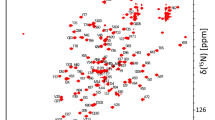Abstract
Streptococcus parasanguinis is a primary colonizer of tooth surfaces in the oral cavity. Amylase-binding protein A (AbpA) from S. parasanguinis is responsible for the recruitment of salivary amylase to bacterial surface, which plays an important role in the development of oral biofilms. Here, we describe the essentially complete NMR assignments for AbpA.

Similar content being viewed by others
Abbreviations
- AbpA:
-
Amylase-binding protein A
- IPTG:
-
Isopropyl-d-thiogalactopyranoside
- NOE:
-
Nuclear overhauser effect
- NOESY:
-
Nuclear overhauser effect enhancement spectroscopy
- TOCSY:
-
Total correlation spectroscopy
References
Brown AE, Rogers JD, Haase EM, Zelasko PM, Scannapieco FA (1999) Prevalence of the amylase-binding protein A gene (abpA) in oral streptococci. J Clin Microbiol 37:4081–4085
Camilloni C, De Simone A, Vranken WF, Vendruscolo M (2012) Determination of secondary structure populations in disordered states of proteins using nuclear magnetic resonance chemical shifts. Biochemistry 51:2224–2231
Chaudhuri B, Rojek J, Vickerman MM, Tanzer JM, Scannapieco FA (2007) Interaction of salivary alpha-amylase and amylase-binding-protein A (AbpA) of Streptococcus gordonii with glucosyltransferase of S. gordonii and Streptococcus mutans. BMC Microbiol 7:60
Jung YS, Zweckstetter M (2004) MARS—robust automatic backbone assignment of proteins. J Biomol NMR 30:11–23
Nikitkova AE, Haase EM, Scannapieco FA (2012) Effect of starch and amylase on the expression of amylase-binding protein A in Streptococcus gordonii. Mol Oral Microbiol 27:284–294
Rogers JD, Haase EM, Brown AE, Douglas CW, Gwynn JP, Scannapieco FA (1998) Identification and analysis of a gene (abpA) encoding a major amylase-binding protein in Streptococcus gordonii. Microbiology 144(Pt 5):1223–1233
Rogers JD, Palmer RJ Jr, Kolenbrander PE, Scannapieco FA (2001) Role of Streptococcus gordonii amylase-binding protein A in adhesion to hydroxyapatite, starch metabolism, and biofilm formation. Infect Immun 69:7046–7056
Shen Y, Delaglio F, Cornilescu G, Bax A (2009) TALOS+: a hybrid method for predicting protein backbone torsion angles from NMR chemical shifts. J Biomol NMR 44:213–223
Wu H, Mintz KP, Ladha M, Fives-Taylor PM (1998) Isolation and characterization of Fap1, a fimbriae-associated adhesin of Streptococcus parasanguis FW213. Mol Microbiol 28:487–500
Zhu F, Erlandsen H, Ding L, Li J, Huang Y, Zhou M, Liang X, Ma J, Wu H (2011) Structural and functional analysis of a new subfamily of glycosyltransferases required for glycosylation of serine-rich streptococcal adhesins. J Biol Chem 286:27048–27057
Acknowledgments
This work was supported by a Wellcome Trust Senior Investigator Award to SM and NIH/NIDCR DE022673 and DE017954.
Author information
Authors and Affiliations
Corresponding author
Rights and permissions
About this article
Cite this article
Liu, B., Zhu, F., Wu, H. et al. NMR assignment of the amylase-binding protein A from Streptococcus parasanguinis . Biomol NMR Assign 9, 173–175 (2015). https://doi.org/10.1007/s12104-014-9568-9
Received:
Accepted:
Published:
Issue Date:
DOI: https://doi.org/10.1007/s12104-014-9568-9




